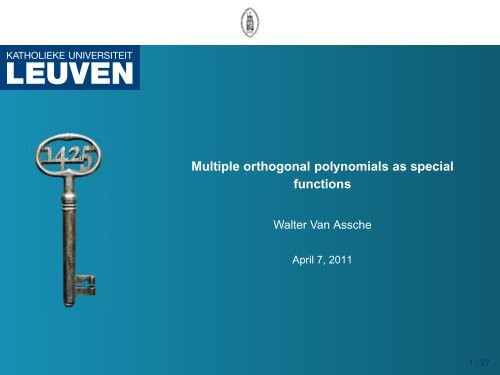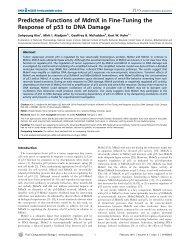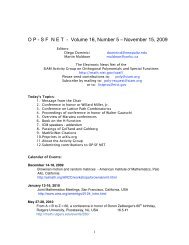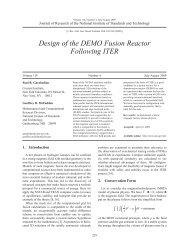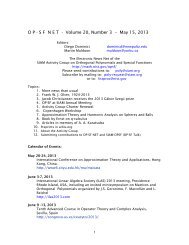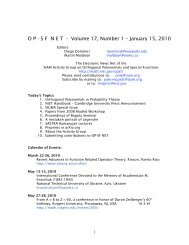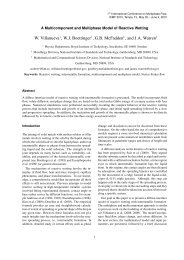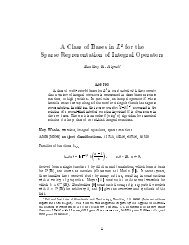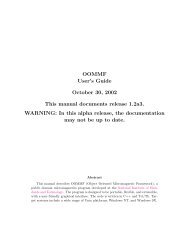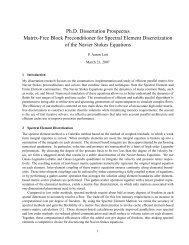Multiple orthogonal polynomials as special functions
Multiple orthogonal polynomials as special functions
Multiple orthogonal polynomials as special functions
Create successful ePaper yourself
Turn your PDF publications into a flip-book with our unique Google optimized e-Paper software.
<strong>Multiple</strong> <strong>orthogonal</strong> <strong>polynomials</strong> <strong>as</strong> <strong>special</strong><br />
<strong>functions</strong><br />
Walter Van Assche<br />
April 7, 2011<br />
1 / 27
<strong>Multiple</strong> <strong>orthogonal</strong> <strong>polynomials</strong><br />
<strong>Multiple</strong> <strong>orthogonal</strong><br />
<strong>polynomials</strong><br />
definition<br />
type II multiple<br />
<strong>orthogonal</strong> <strong>polynomials</strong><br />
type I multiple<br />
<strong>orthogonal</strong> <strong>polynomials</strong><br />
Determinantal point<br />
processes<br />
Recurrence relations<br />
Various examples<br />
2 / 27
definition<br />
Polynomials of one variable but indexed by a multi-index<br />
n = (n1,n2,...,nr) ∈ N r (r ≥ 1) satisfying <strong>orthogonal</strong>ity<br />
conditions with respect tor positive me<strong>as</strong>ureµ1,...,µr on the<br />
real line.<br />
They appear naturally in Hermite-Padé approximation tor<br />
<strong>functions</strong><br />
fj(z) =<br />
<br />
dµj(x)<br />
, 1 ≤ j ≤ r.<br />
z −x<br />
There are two types: type I and type II<br />
<strong>Multiple</strong> <strong>orthogonal</strong><br />
<strong>polynomials</strong><br />
definition<br />
type II multiple<br />
<strong>orthogonal</strong> <strong>polynomials</strong><br />
type I multiple<br />
<strong>orthogonal</strong> <strong>polynomials</strong><br />
Determinantal point<br />
processes<br />
Recurrence relations<br />
Various examples<br />
3 / 27
type II multiple <strong>orthogonal</strong> <strong>polynomials</strong><br />
Pn is a monic polynomial of degree|n| = n1 +n2 +···+nr<br />
for which<br />
<br />
Pn(x)x k dµ1(x) = 0, k = 0,1,...,n1 −1<br />
<br />
.<br />
Pn(x)x k dµr(x) = 0, k = 0,1,...,nr −1<br />
|n| linear conditions for|n| unknowns.<br />
Solution exists and unique: n is a normal index for type II.<br />
<strong>Multiple</strong> <strong>orthogonal</strong><br />
<strong>polynomials</strong><br />
definition<br />
type II multiple<br />
<strong>orthogonal</strong> <strong>polynomials</strong><br />
type I multiple<br />
<strong>orthogonal</strong> <strong>polynomials</strong><br />
Determinantal point<br />
processes<br />
Recurrence relations<br />
Various examples<br />
4 / 27
type I multiple <strong>orthogonal</strong> <strong>polynomials</strong><br />
(An,1,...,An,r) is a vector ofr <strong>polynomials</strong>, withAn,j of<br />
degreenj −1, for which<br />
<br />
<br />
x k<br />
x |n|−1<br />
r<br />
An,j dµj(x) = 0, k = 0,1,...,|n|−2<br />
j=1<br />
r<br />
An,j dµj(x) = 1.<br />
j=1<br />
|n| linear conditions for|n| unknowns.<br />
Solution exists and unique: n is a normal index for type I (⇔for<br />
type II).<br />
Notation:<br />
Qn(x) =<br />
r<br />
j=1<br />
An,j(x)wj(x), wj(x) = dµj(x)<br />
dµ(x) .<br />
<strong>Multiple</strong> <strong>orthogonal</strong><br />
<strong>polynomials</strong><br />
definition<br />
type II multiple<br />
<strong>orthogonal</strong> <strong>polynomials</strong><br />
type I multiple<br />
<strong>orthogonal</strong> <strong>polynomials</strong><br />
Determinantal point<br />
processes<br />
Recurrence relations<br />
Various examples<br />
5 / 27
Determinantal point processes<br />
<strong>Multiple</strong> <strong>orthogonal</strong><br />
<strong>polynomials</strong><br />
Determinantal point<br />
processes<br />
what?<br />
definition<br />
bi<strong>orthogonal</strong> ensembles<br />
random matrices<br />
random matrices with<br />
external source<br />
non-intersecting<br />
Brownian motions<br />
non-intersecting<br />
Brownian motions<br />
squared Bessel paths<br />
Recurrence relations<br />
Various examples<br />
6 / 27
what?<br />
Surveys<br />
■ A. Borodin: Determinantal point processes, arXiv:0911.1153 [math.PR]<br />
■ T. Tao: http://terrytao.worldpress.com/2009/08/23/determinantal-processes<br />
■ A. Soshnikov: Determinantal random point fields, Russian Math. Surveys 55<br />
(2000)<br />
■ R. Lyons: Determinantal probability me<strong>as</strong>ures, Publ. Math. Inst. Hautes<br />
Etudes Sci. 98 (2003)<br />
■ K. Johansson: Random matrices and determinantal processes,<br />
arXiv:math-ph/0510038<br />
7 / 27
definition<br />
A point process onRis determinantal if there exists a kernel<br />
K : R×R → R such that<br />
Pr{∃ particle in each(xi,xi +dxi),1 ≤ i ≤ n}<br />
= det K(xi,xj) n<br />
i,j=1 dx1dx2...dxn.<br />
(provided these probabilities are positive, of course).<br />
<strong>Multiple</strong> <strong>orthogonal</strong><br />
<strong>polynomials</strong><br />
Determinantal point<br />
processes<br />
what?<br />
definition<br />
bi<strong>orthogonal</strong> ensembles<br />
random matrices<br />
random matrices with<br />
external source<br />
non-intersecting<br />
Brownian motions<br />
non-intersecting<br />
Brownian motions<br />
squared Bessel paths<br />
Recurrence relations<br />
Various examples<br />
8 / 27
i<strong>orthogonal</strong> ensembles<br />
If(φi)i=1,2,...,n and(ψi)i=1,2,...,n are <strong>functions</strong> onRand<br />
Zn =<br />
<br />
R n<br />
det φi(xj) n<br />
i,j=1 det ψi(xj) n<br />
i,j=1 dx1...dxn,<br />
then the point process with<br />
P(x1,...,xn) = Z −1<br />
n det φi(xj) n<br />
i,j=1 det ψi(xj) n<br />
i,j=1<br />
is determinantal with<br />
and<br />
K(x,y) =<br />
n<br />
i=1<br />
Gi,j =<br />
<br />
n<br />
(G −1 )i,jφi(x)ψj(y),<br />
j=1<br />
R<br />
φi(x)ψj(x)dx<br />
<strong>Multiple</strong> <strong>orthogonal</strong><br />
<strong>polynomials</strong><br />
Determinantal point<br />
processes<br />
what?<br />
definition<br />
bi<strong>orthogonal</strong> ensembles<br />
random matrices<br />
random matrices with<br />
external source<br />
non-intersecting<br />
Brownian motions<br />
non-intersecting<br />
Brownian motions<br />
squared Bessel paths<br />
Recurrence relations<br />
Various examples<br />
9 / 27
andom matrices<br />
For the Gaussian Unitary Ensemble (GUE) of Hermitiann×n<br />
matricesM with probability distribution<br />
Z −1<br />
n e −2TrV(M) dM<br />
the eigenvalues are a determinantal point process with<br />
K(x,y) =<br />
n−1 <br />
i=0<br />
pi(x)pi(y)e −V(x)−V(y)<br />
wherep0(x),p1(x),p2(x),... are the orthonormal <strong>polynomials</strong><br />
for the weighte −2V(x) :<br />
<br />
pi(x)pj(x)e −2V(x) dx = δm,n<br />
<strong>Multiple</strong> <strong>orthogonal</strong><br />
<strong>polynomials</strong><br />
Determinantal point<br />
processes<br />
what?<br />
definition<br />
bi<strong>orthogonal</strong> ensembles<br />
random matrices<br />
random matrices with<br />
external source<br />
non-intersecting<br />
Brownian motions<br />
non-intersecting<br />
Brownian motions<br />
squared Bessel paths<br />
Recurrence relations<br />
Various examples<br />
10 / 27
andom matrices with external source<br />
IfAis a given Hermitiann×n matrix and the probability<br />
distribution is<br />
Z −1<br />
n e −Tr(V(M)+AM) dM,<br />
then the eigenvalues are a determinantal process with<br />
K(x,y) =<br />
|n|−1<br />
<br />
i=0<br />
Pni (x)Qni+1 (x)<br />
wherePn andQn are multiple <strong>orthogonal</strong> <strong>polynomials</strong> for the<br />
me<strong>as</strong>urese −V(x)−ajx (1 ≤ j ≤ r), witha1,...,ar the<br />
eigenvalues ofAandnj the multiplicity of the eigenvaluesaj.<br />
The multi-indices(n0,...,nn) are a path inN r fromn0 =0 to<br />
n |n| = n such thatni+1 −ni =ej for somej ∈ {1,...,r}<br />
ande1,...,er are the unit vectors inN r .<br />
<strong>Multiple</strong> <strong>orthogonal</strong><br />
<strong>polynomials</strong><br />
Determinantal point<br />
processes<br />
what?<br />
definition<br />
bi<strong>orthogonal</strong> ensembles<br />
random matrices<br />
random matrices with<br />
external source<br />
non-intersecting<br />
Brownian motions<br />
non-intersecting<br />
Brownian motions<br />
squared Bessel paths<br />
Recurrence relations<br />
Various examples<br />
11 / 27
non-intersecting Brownian motions<br />
<strong>Multiple</strong> <strong>orthogonal</strong><br />
<strong>polynomials</strong><br />
Determinantal point<br />
processes<br />
what?<br />
definition<br />
bi<strong>orthogonal</strong> ensembles<br />
random matrices<br />
random matrices with<br />
external source<br />
non-intersecting<br />
Brownian motions<br />
non-intersecting<br />
Brownian motions<br />
squared Bessel paths<br />
Recurrence relations<br />
Various examples<br />
12 / 26
non-intersecting Brownian motions<br />
<strong>Multiple</strong> <strong>orthogonal</strong><br />
<strong>polynomials</strong><br />
Determinantal point<br />
processes<br />
what?<br />
definition<br />
bi<strong>orthogonal</strong> ensembles<br />
random matrices<br />
random matrices with<br />
external source<br />
non-intersecting<br />
Brownian motions<br />
non-intersecting<br />
Brownian motions<br />
squared Bessel paths<br />
Recurrence relations<br />
Various examples<br />
13 / 26
squared Bessel paths<br />
Y(t) = X 2 1(t)+X 2 2(t)+···+X 2 d (t)<br />
where(X1(t),X2(t),...,Xd(t)) is ad-dimensional Brownian<br />
motion starting from(a1,...,ad) and ending at(0,0,...,0).<br />
This is a bi<strong>orthogonal</strong> ensemble which uses modified Bessel<br />
<strong>functions</strong>Iα withd = 2(α+1).<br />
<strong>Multiple</strong> <strong>orthogonal</strong><br />
<strong>polynomials</strong><br />
Determinantal point<br />
processes<br />
what?<br />
definition<br />
bi<strong>orthogonal</strong> ensembles<br />
random matrices<br />
random matrices with<br />
external source<br />
non-intersecting<br />
Brownian motions<br />
non-intersecting<br />
Brownian motions<br />
squared Bessel paths<br />
Recurrence relations<br />
Various examples<br />
14 / 27
Recurrence relations<br />
<strong>Multiple</strong> <strong>orthogonal</strong><br />
<strong>polynomials</strong><br />
Determinantal point<br />
processes<br />
Recurrence relations<br />
nearest neighbor<br />
recurrence relations<br />
compatibility relation<br />
Christoffel-Darboux<br />
formula<br />
Various examples<br />
15 / 27
nearest neighbor recurrence relations<br />
Orthogonal <strong>polynomials</strong> on the real line always satisfy a<br />
three-term recurrence relation.<br />
xpn(x) = an+1pn+1(x)+bnpn(x)+anpn−1(x).<br />
<strong>Multiple</strong> <strong>orthogonal</strong> <strong>polynomials</strong> (with all multi-indices normal)<br />
satisfy a system ofr recurrence relations<br />
xPn(x) = Pn+ek (x)+bn,kPn(x)+<br />
r<br />
j=1<br />
xQn(x) = Qn−ek (x)+bn−ek,kQn(x)+<br />
an,jPn−ej<br />
r<br />
j=1<br />
an,jQn+ej<br />
(x), 1 ≤ k ≤ r.<br />
<strong>Multiple</strong> <strong>orthogonal</strong><br />
<strong>polynomials</strong><br />
Determinantal point<br />
processes<br />
Recurrence relations<br />
nearest neighbor<br />
recurrence relations<br />
compatibility relation<br />
Christoffel-Darboux<br />
formula<br />
Various examples<br />
(x), 1 ≤ k ≤ r.<br />
16 / 27
compatibility relation<br />
The recurrence coefficients satisfy some partial difference<br />
equations (Van Assche, 2011).<br />
Suppose1 ≤ i = j ≤ r, then<br />
bn+ei,j −bn,j = bn+ej,i −bn,i<br />
r r<br />
<br />
bn+ej,i bn,i<br />
an+ej,k − an+ei,k = det<br />
bn+ei,j bn,j<br />
j=1 k=1<br />
an,i<br />
an+ej,i<br />
= bn−ei,j −bn−ei,i<br />
bn,j −bn,i<br />
Re<strong>as</strong>on: Pn+ei+ej (x) can be computed in two ways from the<br />
recurrence relations:<br />
■ first computePn+ei<br />
■ first computePn+ej<br />
(x) and from therePn+ei+ej (x)<br />
(x) and from therePn+ej+ei (x)<br />
<br />
<strong>Multiple</strong> <strong>orthogonal</strong><br />
<strong>polynomials</strong><br />
Determinantal point<br />
processes<br />
Recurrence relations<br />
nearest neighbor<br />
recurrence relations<br />
compatibility relation<br />
Christoffel-Darboux<br />
formula<br />
Various examples<br />
17 / 27
Christoffel-Darboux formula<br />
For <strong>orthogonal</strong> <strong>polynomials</strong> there is the Christoffel-Darboux<br />
relation<br />
n−1 <br />
i=0<br />
pi(x)pi(y) = an<br />
pn(x)pn−1(y)−pn−1(x)pn(y)<br />
x−y<br />
For multiple <strong>orthogonal</strong> <strong>polynomials</strong> there is a similar formula<br />
|n|−1<br />
<br />
i=0<br />
Pni (x)Qni+1 (y) = Pn(x)Qn(y)− r<br />
j=1<br />
an,jPn−ej (x)Qn+ej (y)<br />
x−y<br />
where(ni) i=0,1,...,|n| is a path inN r fromn0 =0 ton |n| = n<br />
such that for eachi ∈ {0,1,...,|n|−1} one h<strong>as</strong><br />
ni+1 −ni =ej for somej ∈ {1,2,...,r} (Kuijlaars &<br />
Daems).<br />
<strong>Multiple</strong> <strong>orthogonal</strong><br />
<strong>polynomials</strong><br />
Determinantal point<br />
processes<br />
Recurrence relations<br />
nearest neighbor<br />
recurrence relations<br />
compatibility relation<br />
Christoffel-Darboux<br />
formula<br />
Various examples<br />
.<br />
18 / 27
Various examples<br />
<strong>Multiple</strong> <strong>orthogonal</strong><br />
<strong>polynomials</strong><br />
Determinantal point<br />
processes<br />
Recurrence relations<br />
Various examples<br />
multiple Hermite<br />
<strong>polynomials</strong><br />
multiple Laguerre<br />
<strong>polynomials</strong>, first kind<br />
multiple Laguerre<br />
<strong>polynomials</strong>, second<br />
kind<br />
multiple Jacobi<br />
<strong>polynomials</strong><br />
multiple Jacobi<br />
<strong>polynomials</strong><br />
multiple <strong>orthogonal</strong><br />
<strong>polynomials</strong> and<br />
modified Bessel<br />
<strong>functions</strong>I<br />
multiple <strong>orthogonal</strong><br />
<strong>polynomials</strong> and<br />
modified Bessel<br />
<strong>functions</strong>K<br />
references<br />
19 / 27
multiple Hermite <strong>polynomials</strong><br />
∞<br />
−∞<br />
x k Hn(x)e −x2 +cjx dx = 0, k = 0,1,...,nj −1<br />
whereci ≤ cj wheneveri = j.<br />
random matrices with external source (Kuijlaars & Bleher),<br />
non-intersection Brownian motions (Kuijlaars, Daems, Delvaux,<br />
Bleher)<br />
Rodrigues formula<br />
e −x2<br />
Hn(x) = (−1) |n| 2 −|n|<br />
⎛<br />
⎝<br />
r<br />
e<br />
j=1<br />
Recurrence relations: for1 ≤ k ≤ r<br />
ck 1<br />
xHn(x) = Hn+ek (x)+ Hn(x)+<br />
2 2<br />
−cjx dnj<br />
dx<br />
r<br />
j=1<br />
nj ecjx<br />
⎞<br />
⎠e −x2<br />
.<br />
njHn−ej (x).<br />
<strong>Multiple</strong> <strong>orthogonal</strong><br />
<strong>polynomials</strong><br />
Determinantal point<br />
processes<br />
Recurrence relations<br />
Various examples<br />
multiple Hermite<br />
<strong>polynomials</strong><br />
multiple Laguerre<br />
<strong>polynomials</strong>, first kind<br />
multiple Laguerre<br />
<strong>polynomials</strong>, second<br />
kind<br />
multiple Jacobi<br />
<strong>polynomials</strong><br />
multiple Jacobi<br />
<strong>polynomials</strong><br />
multiple <strong>orthogonal</strong><br />
<strong>polynomials</strong> and<br />
modified Bessel<br />
<strong>functions</strong>I<br />
multiple <strong>orthogonal</strong><br />
<strong>polynomials</strong> and<br />
modified Bessel<br />
<strong>functions</strong>K<br />
references<br />
20 / 27
multiple Laguerre <strong>polynomials</strong>, first kind<br />
∞<br />
0<br />
x k Ln(x)x αj e −x dx = 0, k = 0,1,...,nj −1<br />
whereα1,...,αr > −1 andαi −αj /∈ Z.<br />
(−1) |n| e −x Ln(x) =<br />
r<br />
j=1<br />
<br />
x<br />
−αj dnj<br />
dx<br />
xLn(x) = Ln+ek (x)+bn,kLn(x)+<br />
an,j = nj(nj +αj)<br />
r<br />
i=1,i=j<br />
nj xnj+αj<br />
r<br />
j=1<br />
bn,j = |n|+nj +αj +1.<br />
nj +αj −αi<br />
<br />
e −x<br />
an,jLn−ej (x)<br />
nj −ni +αj −αi<br />
<strong>Multiple</strong> <strong>orthogonal</strong><br />
<strong>polynomials</strong><br />
Determinantal point<br />
processes<br />
Recurrence relations<br />
Various examples<br />
multiple Hermite<br />
<strong>polynomials</strong><br />
multiple Laguerre<br />
<strong>polynomials</strong>, first kind<br />
multiple Laguerre<br />
<strong>polynomials</strong>, second<br />
kind<br />
multiple Jacobi<br />
<strong>polynomials</strong><br />
multiple Jacobi<br />
<strong>polynomials</strong><br />
multiple <strong>orthogonal</strong><br />
<strong>polynomials</strong> and<br />
modified Bessel<br />
<strong>functions</strong>I<br />
multiple <strong>orthogonal</strong><br />
<strong>polynomials</strong> and<br />
modified Bessel<br />
<strong>functions</strong>K<br />
references<br />
21 / 27
multiple Laguerre <strong>polynomials</strong>, second kind<br />
∞<br />
0<br />
x k Ln(x)x α e −cjx dx = 0, k = 0,1,...,nj −1<br />
withc1,...,cr > 0 andci = cj wheneveri = j.<br />
Wishart ensembles in random matrix theory.<br />
(−1) |n|<br />
⎛<br />
⎝<br />
r<br />
j=1<br />
c nj<br />
j<br />
⎞<br />
⎠x α Ln(x) =<br />
r<br />
j=1<br />
<br />
e<br />
xLn(x) = Ln+ek (x)+bn,kLn(x)+<br />
an,j = |n|+α)nj<br />
c 2 j<br />
cjx dnj<br />
dx<br />
r<br />
j=1<br />
, bn,j = |n|+α+1<br />
cj<br />
nj e−cjx<br />
<br />
x |n|+α<br />
an,jLn−ej (x)<br />
+<br />
r<br />
i=1<br />
ni<br />
ci<br />
<strong>Multiple</strong> <strong>orthogonal</strong><br />
<strong>polynomials</strong><br />
Determinantal point<br />
processes<br />
Recurrence relations<br />
Various examples<br />
multiple Hermite<br />
<strong>polynomials</strong><br />
multiple Laguerre<br />
<strong>polynomials</strong>, first kind<br />
multiple Laguerre<br />
<strong>polynomials</strong>, second<br />
kind<br />
multiple Jacobi<br />
<strong>polynomials</strong><br />
multiple Jacobi<br />
<strong>polynomials</strong><br />
multiple <strong>orthogonal</strong><br />
<strong>polynomials</strong> and<br />
modified Bessel<br />
<strong>functions</strong>I<br />
multiple <strong>orthogonal</strong><br />
<strong>polynomials</strong> and<br />
modified Bessel<br />
<strong>functions</strong>K<br />
references<br />
22 / 27
multiple Jacobi <strong>polynomials</strong><br />
1<br />
0<br />
x k Pn(x)x αj (1−x) β dx = 0, k = 0,1,...,nj −1<br />
withα1,...,αr,β > −1 andαi −αj /∈ Z.<br />
(−1) |n|<br />
r<br />
(|n|+αj +β +1)nj (1−x)β Pn(x)<br />
j=1<br />
=<br />
r<br />
j=1<br />
<br />
x<br />
−αj dnj<br />
dx<br />
nj xnj+αj<br />
<br />
(1−x) |n|+β<br />
<strong>Multiple</strong> <strong>orthogonal</strong><br />
<strong>polynomials</strong><br />
Determinantal point<br />
processes<br />
Recurrence relations<br />
Various examples<br />
multiple Hermite<br />
<strong>polynomials</strong><br />
multiple Laguerre<br />
<strong>polynomials</strong>, first kind<br />
multiple Laguerre<br />
<strong>polynomials</strong>, second<br />
kind<br />
multiple Jacobi<br />
<strong>polynomials</strong><br />
multiple Jacobi<br />
<strong>polynomials</strong><br />
multiple <strong>orthogonal</strong><br />
<strong>polynomials</strong> and<br />
modified Bessel<br />
<strong>functions</strong>I<br />
multiple <strong>orthogonal</strong><br />
<strong>polynomials</strong> and<br />
modified Bessel<br />
<strong>functions</strong>K<br />
references<br />
23 / 27
multiple Jacobi <strong>polynomials</strong><br />
xPn(x) = Pn+ek (x)+bn,kPn(x)+<br />
r<br />
j=1<br />
an,jPn−ej (x)<br />
Letqr(x) = r<br />
j=1 (x−αj) andQr,n(x) = r<br />
j=1 (x−nj −αj), then<br />
an,j = qr(−|n|−β)qr(nj +αj)<br />
Qr,n(−|n|−β)Q ′ r,n (nj +αj)<br />
(nj +αj)(|n|+β)<br />
(|n|+nj +αj +β +1)(|n|+nj +αj +β)(|n|+nj +αj +β −1)<br />
bn,j = δn −δn+ej , δn = −(|n|+β) qr(−|n|−β)<br />
Qr,n(−|n|−β) .<br />
24 / 27
multiple <strong>orthogonal</strong> <strong>polynomials</strong> and modified Bessel<br />
<strong>functions</strong>I<br />
∞<br />
0<br />
∞<br />
0<br />
x k Pn,m(x)x ν/2 Iν(2 √ x)e −cx dx = 0, k = 0,1,...,n−1<br />
x k Pn,m(x)x (ν+1)/2 Iν+1(2 √ x)e −cx dx = 0, k = 0,1,...,m−1<br />
withν > −1 andc > 0. Ifp2n(x) = Pn,n(x) andp2n+1(x) = Pn+1,n(x),<br />
then<br />
with<br />
bn =<br />
xpn(x) = pn+1(x)+bnpn(x)+cnpn−1(x)+dnpn−2(x)<br />
c(2n+ν +1))+1<br />
c 2<br />
andy = pn(x) satisfies<br />
, cn = n(2+c(n+ν))<br />
c3 , dn = n(n−1)<br />
c4 xy ′′′ +(−2cx+ν +2)y ′′ +(c 2 x+c(n−ν −2)−1)y ′ −c 2 ny = 0.<br />
25 / 27
multiple <strong>orthogonal</strong> <strong>polynomials</strong> and modified Bessel<br />
<strong>functions</strong>K<br />
∞<br />
0<br />
∞<br />
0<br />
x k Pn,m(x)x α+ν/2 Kν(2 √ x)dx = 0, k = 0,1,...,n−1<br />
x k Pn,m(x)x α+(ν+1)/2 Kν+1(2 √ x)dx = 0, k = 0,1,...,m−1<br />
withα > −1 andν ≥ 0. Letp2n(x) = Pn,n(x) andp2n+1(x) = Pn+1,n(x)<br />
xpn(x) = pn+1(x)+bnpn(x)+cnpn−1(x)+dnpn−2(x)<br />
bn = (n+α+1)(3n+α+2ν)−(α+1)(ν −1),<br />
cn = n(n+α)(n+α+ν)(3n+2α+ν),<br />
dn = n(n−1)(n+α−1)(n+α)(n+α+ν −1)(n+α+ν)<br />
andy = pn(x) satisfies<br />
x 2 y ′′′ +x(2α+ν +3)y ′′ +[(α+1)(α+ν +1)−x]y ′ +ny = 0.<br />
26 / 27
eferences<br />
■ Chapter 23: <strong>Multiple</strong> Orthogonal Polynomials in “Cl<strong>as</strong>sical and Quantum<br />
Orthogonal Polynomials of one Variable” (M.E.H. Ismail), Cambridge<br />
University Press, 2005.<br />
■ A.I. Aptekarev, A. Branquinho, W. Van Assche, <strong>Multiple</strong> <strong>orthogonal</strong><br />
<strong>polynomials</strong> for cl<strong>as</strong>sical weights, Trans. Amer. Math. Soc. 355 ((2003)<br />
■ E. Coussement, W. Van Assche, <strong>Multiple</strong> <strong>orthogonal</strong> <strong>polynomials</strong> <strong>as</strong>sociated<br />
with the modified Bessel <strong>functions</strong> of the first kind, Constr. Approx. 19 (2003)<br />
■ J. Coussement, W. Van Assche, Differential equations for multiple <strong>orthogonal</strong><br />
<strong>polynomials</strong> with respect to cl<strong>as</strong>sical weights: raising and lowering operators,<br />
J. Phys. A: Math. Gen. 39 (2006)<br />
■ W. Van Assche, Nearest neighbor recurrence relations for multiple <strong>orthogonal</strong><br />
<strong>polynomials</strong>, manuscript<br />
■ A.B.J. Kuijlaars, <strong>Multiple</strong> <strong>orthogonal</strong> polynomial ensembles, Contemporary<br />
Mathematics 507 (2010)<br />
27 / 27


